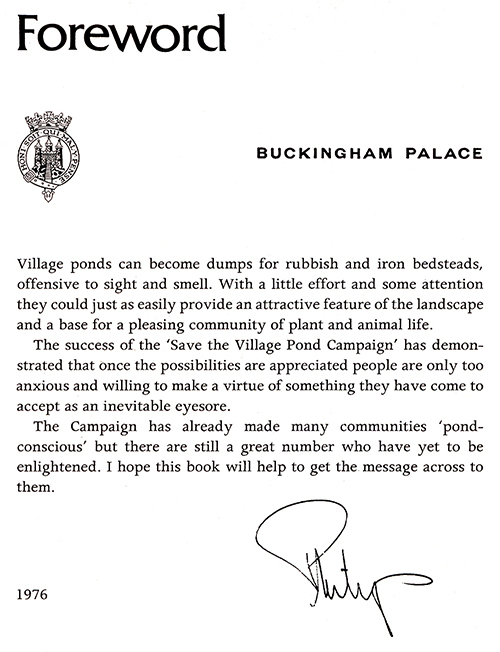August 2021 – Alder Moth Caterpillar.
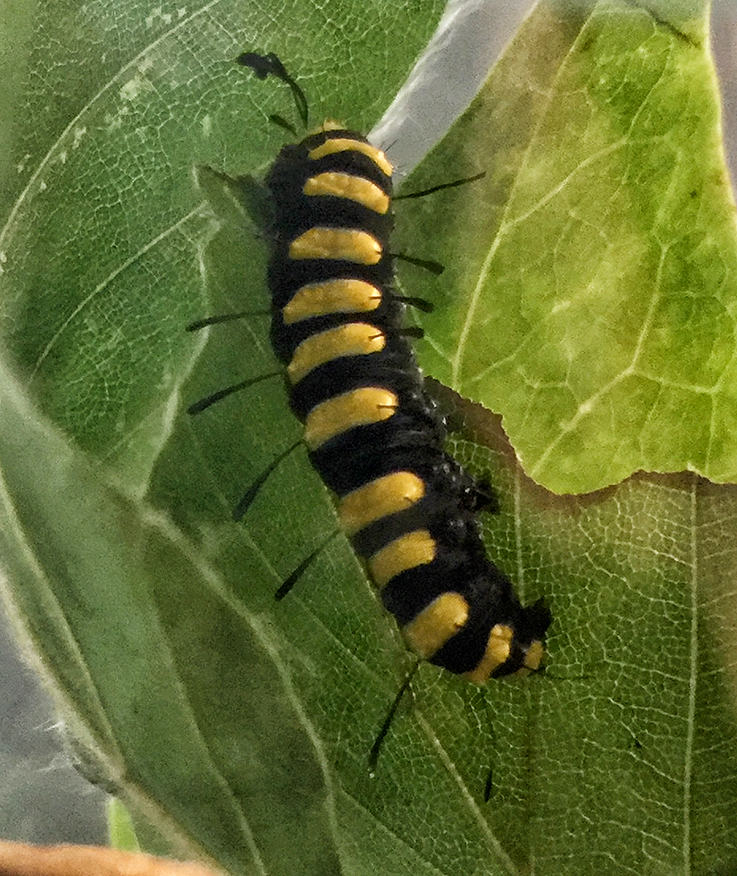 Photo © Keith Littlejohns.
Photo © Keith Littlejohns.
The Alder Moth, Acronicta alni is thinly scattered over most of southern England and Wales. In the south west of the British Isles it’s most commonly found in damp, mixed deciduous, wooded areas. The adult moth is subtly-marked in shades of browns, black and grey.
The fully grown, distinctive, yellow and black striped caterpillars with black ‘paddles’ are 30-35 mm in length.
Although the larvae feed on a wide variety of deciduous trees they are not commonly found when searching, tending to hide underneath leaves.
Keith Littlejohns
July 2021 – Common Lizard.
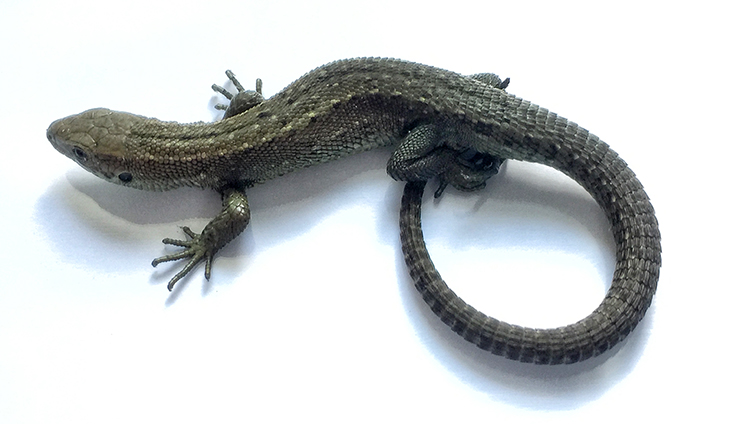 Photo © Keith Littlejohns.
Photo © Keith Littlejohns.
This Common Lizard, Zootoca vivipara was found sunning itself on top of some pieces of old timber just inside our open garage door in full sun. However, being too awkward to photograph properly where it was I managed to coax it to climb onto a piece of sun warmed melamine coated chipboard to get a better photo. Once disturbed though it became more lively, making me hurriedly take a series of shots using my iPhone before it scampered away into the garden.
Common lizards are widespread throughout the UK. Commonly found in grassland, heathland, woodland edges, moorland and sometimes gardens. They seek out warm bathing in spots of sunshine.
Although colour can vary from almost black to vivid green, the common lizard is more usually brown with a pattern of stripes or spots. Typical adult size is approximately 15cm (nose to tail). Males have a larger head and slimmer body than females, and prominent swelling at the base of the tail.
The common lizard feeds on small invertebrates such as flies, spiders and even snails. It hunts by day using sight and scent, warming its body first by basking in the sun.
Instead of laying eggs, this lizard bears ‘live young’. Mating takes place in late spring, after which up to 10 young develop inside the female, giving her a fattened, pregnant look. The young are then ‘born’ in July.
Common Lizards hibernate, often in groups, amongst rocks or dead wood generally between November and March. They may take advantage of milder patches of weather to come out and forage.
Common lizards are protected by law in Great Britain. It is illegal to deliberately kill, injure or sell/trade common lizards.
Keith Littlejohns
International Day for Biological Diversity
 The United Nations has proclaimed May 22 The International Day for Biological Diversity (IDB) to increase understanding and awareness of biodiversity issues.
The United Nations has proclaimed May 22 The International Day for Biological Diversity (IDB) to increase understanding and awareness of biodiversity issues.
The Secretariat of the Convention on Biological Diversity is pleased to announce the Biodiversity Day 2021 slogan: “We’re part of the solution”. The slogan was chosen to be a continuation of the momentum generated last year under the over-arching theme, “Our solutions are in nature”, which served as a reminder that biodiversity remains the answer to several sustainable development challenges. From nature-based solutions to climate, health issues, food and water security, and sustainable livelihoods, biodiversity is the foundation upon which we can build back better.
Given the ongoing COVID-19 pandemic, Biodiversity Day 2021 will be commemorated through an online-only campaign. You are in the best position to know what awareness-raising campaigns and calls to action are feasible at your national level.
https://www.facebook.com/UNBiodiversity
The Wild Garden by W. Robinson – Free eBook
William Robinson FLS (5 July 1838 – 17 May 1935) was an Irish practical gardener and journalist whose ideas about wild gardening spurred the movement that led to the popularising of the English cottage garden, a parallel to the search for honest simplicity and vernacular style of the British Arts and Crafts movement.
In 1866, at the age of 29, he became a fellow of the Linnean Society under the sponsorship of Charles Darwin, James Veitch, David Moore, and seven other distinguished botanists and horticulturists. Two months later, he left Regents Park to write for The Gardener’s Chronicle and The Times, and represented the leading horticultural firm of Veitch at the 1867 Paris Exhibition. He began writing many of his publications, beginning with Gleanings from French Gardens in 1868, The Parks, Gardens, and Promenades of Paris in 1869, and Alpine Flowers for Gardens, Mushroom Culture, and The Wild Garden in 1870. In 1871 he launched his own gardening journal, simply named The Garden, which over the years included contributions from notables such as John Ruskin, Oliver Wendell Holmes, Gertrude Jekyll, William Morris, Dean Hole, Frank Miles, Canon Ellacombe, and James Britten. The Garden: An Illustrated Weekly Journal of Horticulture in All Its Branches was published from 1872 to 1927.
His most influential books were The Wild Garden, which made his reputation and allowed him to start his magazine The Garden; and The English Flower Garden, 1883, which he revised in edition after edition and included contributions from his lifelong friend Gertrude Jekyll, among others. She later edited The Garden for a couple of years and contributed many articles to his publications, which also included Gardening Illustrated (from 1879).
He first met Jekyll in 1875—they were in accord in their design principles and maintained a close friendship and professional association for over 50 years. He helped her on her garden at Munstead Wood; she provided plants for his garden at Gravetye Manor. Jekyll wrote about Robinson that:
…when English gardening was mostly represented by the innate futilities of the “bedding” system, with its wearisome repetitions and garish colouring, Mr William Robinson chose as his work in live to make better known the treasures that were lying neglected, and at the same time to overthrow the feeble follies of the “bedding” system. It is mainly owing to his unremitting labours that a clear knowledge of the world of hardy-plant beauty is now placed within easy reach of all who care to acquire it, and that the “bedding mania” is virtually dead.
Robinson also published God’s Acre Beautiful or The Cemeteries of The Future, in which he applied his gardening aesthetic to urban churchyards and cemeteries. His campaign included trying to win an unwilling public to the advantages of cremation over burial, and he quite freely shared unsavoury stories of what happened in certain crowded graveyards. He was instrumental in the founding of Golders Green Crematorium and designed the gardens there, which replaced the traditional Victorian mourning graveyard with open lawn, flowerbeds, and woodland gardens.
The Wild Garden is now freely available as an eBook (eBook reader required to read the downloadable file) on this link, also on the web on this link as part of Google’s Gutenberg Project.
Enjoy!
Keith Littlejohns
April 2021 – English Bluebell – Hyacinthoides non-scripta
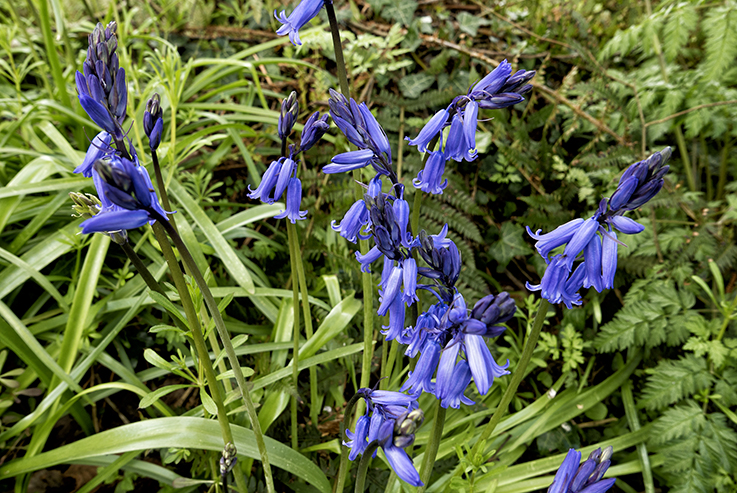 Photo: © Keith Littlejohns.
Photo: © Keith Littlejohns.
Bluebells are native to western Europe with the UK being a species stronghold. They’re associated with ancient woodland and are often used in combination with other species as a clue that a wood is ancient. They reach their greatest densities in the UK’s woods where many thousands of bulbs can exist in one woodland, creating the incredible blue carpets we fondly associate with spring. They also grow along hedgerows and in fields.
The English bluebell should not be confused with Spanish bluebell (Hyacinthoides hispanica), which is very similar in appearance to the English bluebell. However, Spanish bluebells grow upright, with the flowers all around the stem, not drooping to one side like the English bluebell. Hybrid bluebell (Hyacinthoides x massartiana) is a mix of the English and Spanish bluebell. It is often very similar in appearance to our native bluebell, but might threaten its existence by out-competing it and diluting the gene pool.
Many insects reap the benefits of bluebells which flower earlier than many other plants. Woodland butterflies, bees and hoverflies all feed on their nectar. Bees can ‘steal’ the nectar from bluebells by biting a hole in the bottom of the flower, reaching the nectar without the need to pollinate the flower
In the language of flowers, the bluebell is a symbol of humility, constancy, gratitude and everlasting love. It is said that if you turn a bluebell flower inside-out without tearing it, you will win the one you love, and if you wear a wreath of bluebells you will only be able to speak the truth.
Bluebells have been used for a variety of different things throughout history, not just for ornamental purposes. Their sticky sap was once used to bind the pages of books and glue the feathers onto arrows, and during the Elizabethan period, their bulbs were crushed to make starch for the ruffs of collars and sleeves. Due to their toxicity, there has been little use for bluebells in modern medicine. However, their bulbs have diuretic (increases urination) and styptic (helps to stop bleeding) properties, and research on how these flowers could potentially help fight cancer is ongoing.
The bluebell is protected under the Wildlife and Countryside Act (1981). This means digging up the plant or bulb in the countryside is prohibited and landowners are prohibited from removing bluebells from their land to sell. The species was also listed on Schedule 8 of the Act in 1998, which makes trading in wild bluebell bulbs and seeds an offence. This legislation was designed to protect bluebell from unscrupulous bulb collectors who supply garden centres.
Keith Littlejohns
April 2021 – Primrose – Primula vulgaris
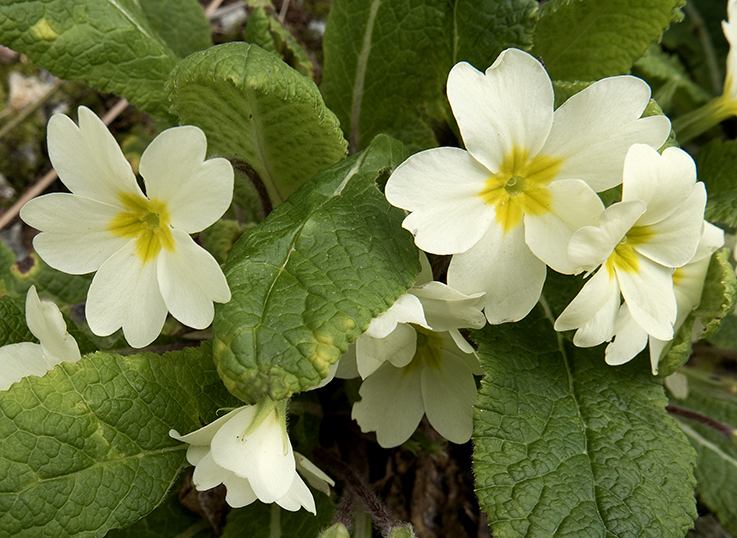 Photo: © Keith Littlejohns.
Photo: © Keith Littlejohns.
The name derives from the Latin prima rosa meaning ‘first rose’ of the year, despite not being a member of the rose family. In different counties of England it is also referred to as butter rose, early rose, Easter rose, golden rose and lent rose.
In large populations there is a variation in the colour, texture and size of primrose flowers. Native species can produce flowers in shades ranging from pale cream to deep yellow. There is even a variety with white flowers round a pale yellow eye, and also a rhubarb-and-custard, or pink, form. Bizarre forms include an umbellate form in which flowers form a spray on top of a longer stalk similar to a cowslip, and doubles.
April 19th is ‘Primrose day’. This date is the anniversary of the death of the former British Prime Minister Benjamin Disraeli and the primrose was his favourite flower. Queen Victoria supposedly sent him bunches regularly and to this day primroses are laid at his statue by Westminster Abbey on this date every year.
Keith Littlejohns
April 2021 – Ground Ivy – Glechoma hederacea
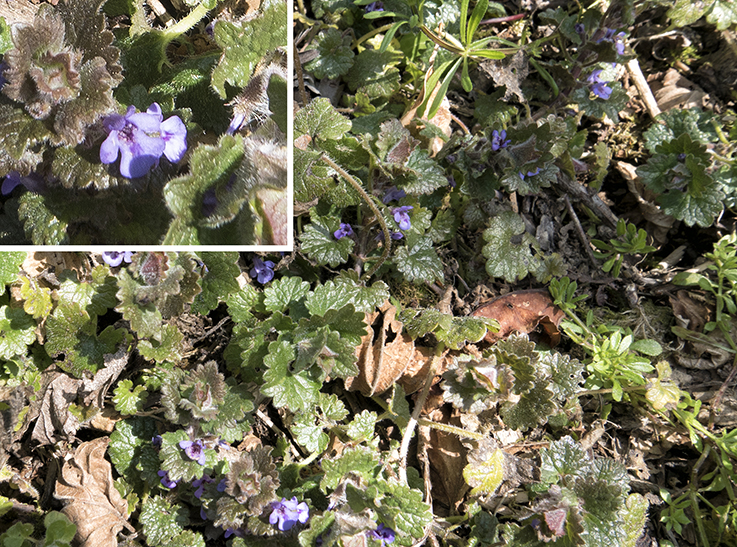 Photo: © Keith Littlejohns.
Photo: © Keith Littlejohns.
An aromatic creeping herb with funnel-shaped violet flowers, the Saxons used this wildflower to flavour and clarify their ale
This small, common evergreen perennial, belonging to the mint family, spreads rapidly in a carpet-like form due to its creeping stems. Despite its name, it is not closely related to common ivy.
It is commonly found in woodlands, meadows, hedgerows, and wasteland throughout the British Isles, although rarer in Scotland. It also thrives in lawns as it survives mowing.
Known as a lung-cleansing herb, it has been used to treat coughs and other respiratory illnesses such as bronchitis.
It has been used a substitute for animal rennet to make cheese.
It is a rich source of vitamin C and can used as a herbal tea.
Common names include Gill-over-the-ground, Creeping Charlie, Alehoof, Tunhoof, Field balm and Run-away Robin. It was known as “Our Lady’s Vine” in Medieval times.
Keith Littlejohns
April 2021 – Trillium – Trillium cuneatum
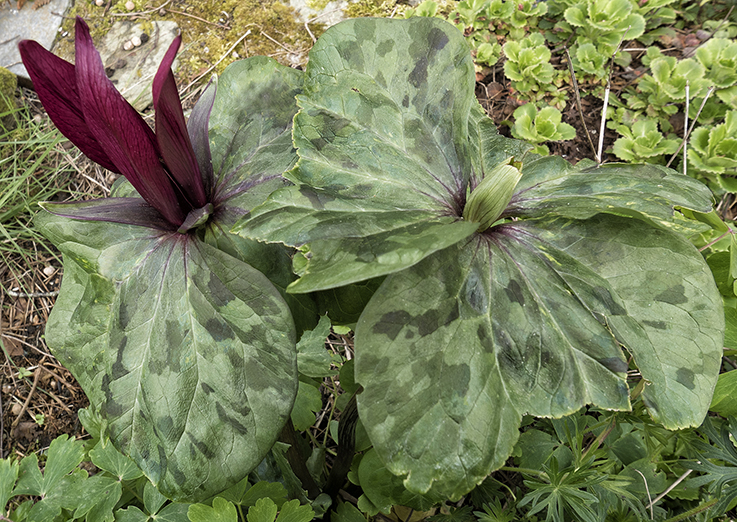 Photo: © Keith Littlejohns.
Photo: © Keith Littlejohns.
Trilliums, also known as wake robin, are low growing spring-flowering perennials with three petals sitting atop three leaves, much like a cup on a saucer. They are slow to establish but are then long lived and readily form colonies. Like peonies they are best planted and left to establish over a number of years.
Trillium species are native to temperate regions of North America and Asia,with the greatest diversity of species found in the southern Appalachian Mountains in the southeastern United States. However, they are readily available for growing in the UK where they have become very popular due to their unique appearance.
Trilliums prefer a neutral to acid soil, but they will grow successfully in a good fertile soil that is rich in organic matter and does not dry out. Although trilliums are moisture lovers, they will not tolerate water logging.
Trilliums are perfect planted between shrubs that provide both shade and shelter from the wind. Alternately, a shady border against a wall or fence is a good location.
Established clumps can be lifted and divided as the foliage dies back. Ensure each piece of rhizome has at least one bud and some roots. Lateral buds can be encouraged by scoring. To do this, scrape back the soil after flowering and score around the base of the terminal bud with a sharp knife. By the following year this will often result in several lateral buds or offsets that can be detached and grown on.
Keith Littlejohns
April 2021 – Opposite-leaved Golden saxifrage – Chrysosplenium oppositifolium
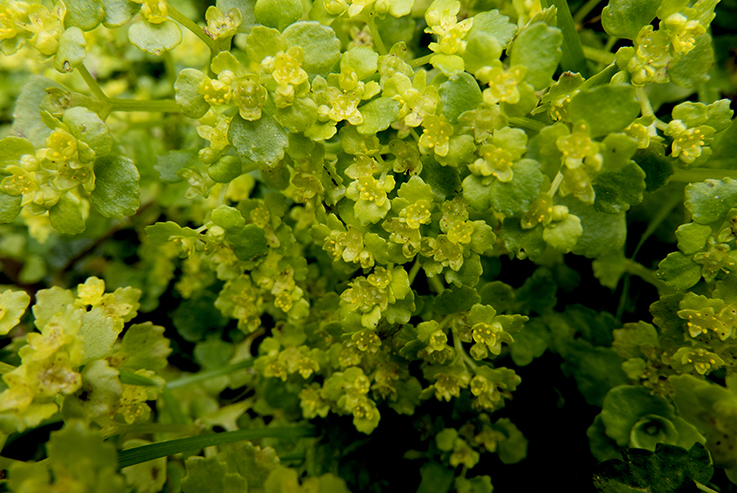 Photo: © Keith Littlejohns.
Photo: © Keith Littlejohns.
Opposite-leaved golden saxifrage tends to grow in creeping matts. It has a square stem and blunt-toothed, paired leaves (alternate-leaved golden saxifrage’s alternate, as its name suggests). Unlike most saxifrages, it has no petals and only eight stamens. Flowers March-June.
Most commonly found in western Britain by streams, in boggy woods, on wet mountain ledges and wet, shady places. Scarcer as one travels east. Prefers acid soil.
Opposite-leaved golden saxifrage’s close relative is ‘Alternate-leaved golden saxifrage’ (Chrysosplenium alternifolium). The latter is less common, has rounder leaves on longer stalks, larger flowers and can be distinguished by the leaves being alternate up the stem, rather than opposite each other and prefers alkaline soil.
Keith Littlejohns
April 2021 – Summer snowflakes – Leucojum aestivum
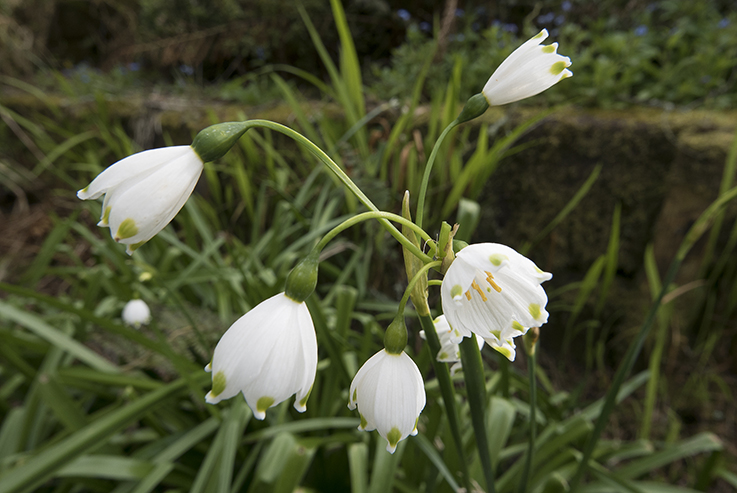 Photo: © Keith Littlejohns.
Photo: © Keith Littlejohns.
Native to much of Europe, with the exception of Scandinavia, Russia, Belarus and the Baltic Republics. Fully hardy in most regions of the UK.
Looking somewhat like a large snowdrop, Leucojum aestivum is a deciduous, perennial bulbous plant, generally 35–60 cm tall, but some forms reach 90 cm. You can tell the difference between the two flowers by the fact that Summer snowflakes have a green dot at the tip of each of its six petals, while snowdrops have dots on only three of its petals.
Its leaves, which are well developed at the time of flowering, are strap-shaped, 5–20 mm wide, reaching to about the same height as the flowers. The flowering stem (scape) is hollow and has wings with translucent margins. The pendant flowers appear in late spring and are borne in umbels of usually three to five, sometimes as many as seven. The flower stalks (pedicels) are of different lengths, 25–70 mm long. The flowers are about 3–4 cm in diameter and have six white tepals, each with a greenish mark just below the tip.
Apart from L. autumnale, which needs a well-drained soil, most other types grow best in a damp position in clay soils, where it generally increases rapidly. Prefers sun or part shade
All species of Leucojum are poisonous, as the leaves and bulbs contain the toxic alkaloids lycorine and galantamine. Galantamine is used for the treatment of cognitive decline in mild to moderate Alzheimer’s disease and various other memory impairments.
Keith Littlejohns
April 2021 – Forget-me-not (common) – Myosotis arvensis
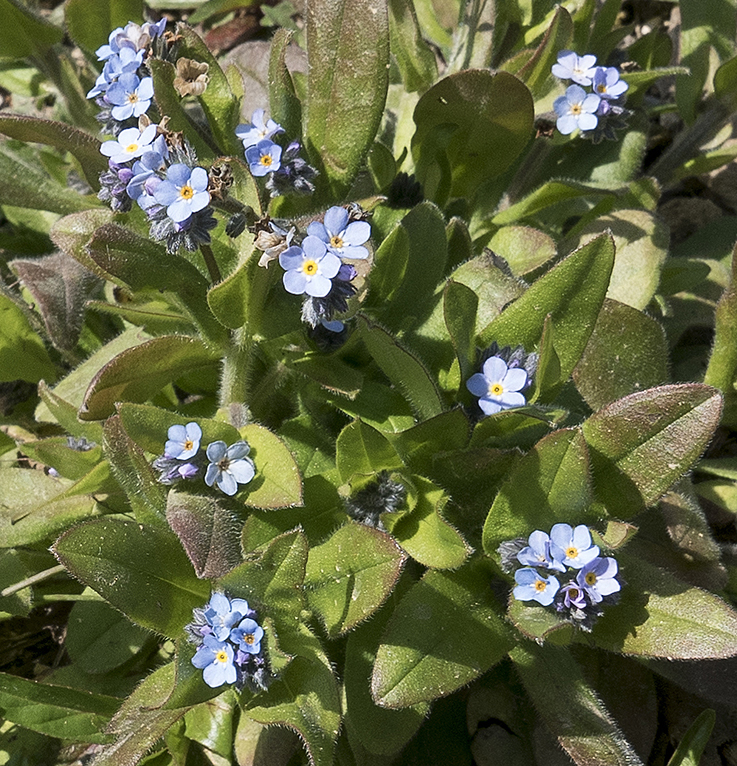 Photo: © Keith Littlejohns.
Photo: © Keith Littlejohns.
Found on cultivated land, roadsides, waste ground and dunes and is a favourite with bees.
An erect plant, its very small, bright blue flowers (sometimes interspersed with pink) occur in spikes. The leaves are oval and hairy, with the ones at the base forming a rosette.
Flowers from April to September.
Their seeds form in small pods along the stem and attach to clothing when brushed against, eventually falling off, allowing the small seed within to germinate elsewhere.
Forget-me-nots used to be known as ‘scorpion-grass’, the current name only appearing in the early 19th century. The name Scorpion-grass arose because the flower clusters are more or less bent over or coiled. Other common names include Bird’s eye, Robin’s eye, Mammy-flooer, Snake-grass and Love-me. The latter is related to the fact that the plant was a symbol of love, and if you wore it you were not forgotten by your lover.
Keith Littlejohns
April 2021 – Lords-and-Ladies – Arum maculatum.
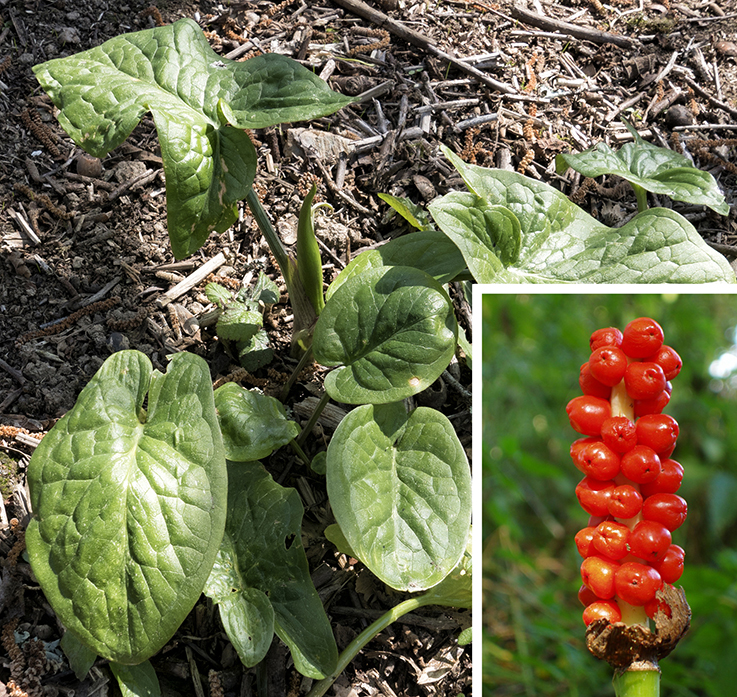 Photo: © Keith Littlejohns.
Photo: © Keith Littlejohns.
An early flowering plant, Lords-and-ladies can be seen in April and May. It is a shade-loving plant of woodlands and hedgerows, and is particularly distinctive as it displays a pale green sheath surrounding a purple or yellow ‘spadix’ (a spike of tiny flowers on a fleshy stem). This spadix eventually produces an upright stalk of bright red berries that is conspicuous among the leaf litter.
Lords-and-ladies are quite common throughout most of the UK. The exception is north and central Scotland.
The flower is designed to attract flies for pollination and club shaped spike releases a urine-like odour. Its fruit – a spike of bright orange berries – can be a common sight in woodlands in autumn. Like many wild berries these are toxic to humans so take care around them.
The plant’s fascinating shape and form has inspired a wide variety of names.
These include:
Jack-in-the-pulpit
Soldier-in-a-sentry-box
Bloody man’s finger
the rather lengthy ‘Kitty-come-down-the-lane-jump-up-and-kiss-me’ (an old Kentish name).
Perhaps not surprisingly, many have rather bawdy associations.
Keith Littlejohns
April 2021 – Common Dandelion – Taraxacum officinale.
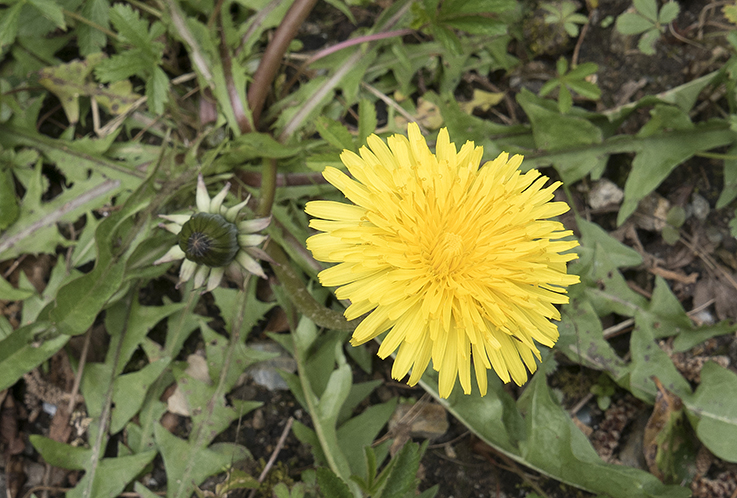 Photo: © Keith Littlejohns.
Photo: © Keith Littlejohns.
This common British native perennial plant manages to find a foothold anywhere there is soil, from the smallest crack or crevice to roadside verges, gardens and fields. An efficient seed distribution mechanism ‘dandelion clock’ and excellent germination characteristics make it easy for the dandelion to spread far and wide. Its long tap root makes it difficult to eradicate, with even the tiniest fragment of root able to regenerate into a full adult plant.
The upside of dandelions is that they are a welcome source of pollen to many insects, and thus, are of benefit to wildlife.
The common dandelion is the subject of many myths and games, one of which suggests that if you pick it, or even just touch it, you will wet the bed – an idea that forms many of the local common names, including ‘Wet-the-bed’ and ‘Tiddle-beds’.
Dandelion has been used in alternative medicine to treat tonsillitis, bladder infections, upset stomach, constipation, arthritis pain, and other conditions. However, these uses have not been established with scientifically proven research on humans. There is no clinical scientific evidence that medications derived from the dandelion is effective in treating any medical condition among the human population.
Keith Littlejohns
April 2021 – An opportune find on my bookshelves.
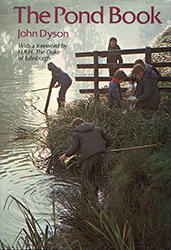 Looking through my library of wildlife books I came across a delightful publication I purchased some years ago on the subject of ponds. The Pond Book, by John Dyson was published by Puffin Books in 1976. The narrative reflects on the demise of the village pond with the aim of enthusing young people to take up the challenge of making a positive contribution to helping revive interest in our, often, ancient village ponds. Many aspects of pond life are described and illustrated including observing and conducting a survey.
Looking through my library of wildlife books I came across a delightful publication I purchased some years ago on the subject of ponds. The Pond Book, by John Dyson was published by Puffin Books in 1976. The narrative reflects on the demise of the village pond with the aim of enthusing young people to take up the challenge of making a positive contribution to helping revive interest in our, often, ancient village ponds. Many aspects of pond life are described and illustrated including observing and conducting a survey.
Of special note is the book’s foreword by HRH The Duke of Edinburgh. This clearly illustrated his passion for highlighting the plight of the natural world and the effect
human beings have had, and continue to have on other species that inhabit the Earth alongside our own.
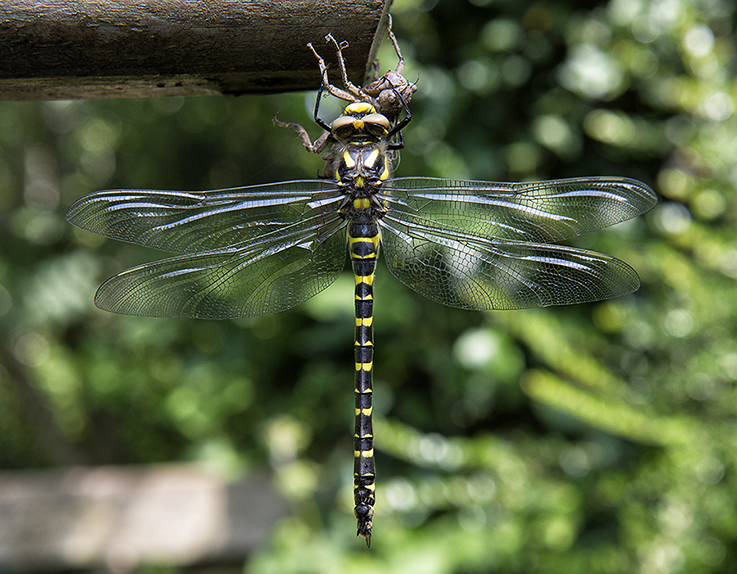 Photo: © Keith Littlejohns
Photo: © Keith Littlejohns
Golden-ringed Dragonfly Cordulegaster boltonii (June 2013)
The iconic aerobatic emperor of the pond
On the subject of ponds, The Golden-ringed Dragonfly Cordulegaster boltonii, is a striking dragonfly and the longest British species, the only member of its genus to be found in the United Kingdom. A very large species, males average 74 mm and the larger females 84 mm. Wingspan is up to 101 mm.
The female lays her eggs in shallow water, having a preference for slow running, acidic streams.
The hairy larvae live at the bottom of the water and are well camouflaged amongst the silt. They emerge after about 2–5 years, and usually under the cover of darkness.
They feed mainly on insects ranging from small prey such as midges, flies, butterflies and even bumblebees.
Flight period is from early June through to end August. Golden-ringed Dragonfly are basically a moorland species hence found chiefly in western side of Great Britain
Keith Littlejohns
April 2021 – Announcement of Passing Away of HRH The Duke of Edinburg, Aged 99 – WWF Tribute to HRH, The Duke of Edinburgh.

We are deeply saddened by news that HRH The Duke of Edinburgh has passed away, and we remain hugely grateful for his lifelong contribution to our work.
His interest in wildlife and nature was long-standing, and Sir Peter Scott invited him to become involved in the founding of WWF. In 1961, The Duke launched WWF’s first national appeal for funds to save the natural world.
As well as visiting hundreds of WWF project sites across five continents, The Duke promoted conservation issues at the highest levels of government and business. He attended and chaired many conservation meetings, conferences and summits – and assisted with fundraising and increasing awareness of our work. He was wholeheartedly committed to inspiring people, from the public to world leaders, to protect nature and wildlife.
The Duke was a powerhouse of persuasion and helped us develop into the respected global conservation organisation we are today
Prince Philip was a pivotal patron of WWF, serving as a passionate voice, advocate and champion for the organization’s work from its creation and particularly as WWF International’s President from 1981 to 1996.
In 1970, WWF established its highest conservation award, eponymously named the Duke of Edinburgh Conservation Award, to recognise and encourage significant achievement in the global environmental field. The Prince was also the first president of WWF-UK, from its establishment in 1961 through 1982.
Pavan Sukhdev, President of WWF International, said:
“The Duke of Edinburgh has been a tireless champion for the environmental cause and a passionate ambassador for conservation issues around the world for decades. His Royal Highness helped chart the course of WWF from its very beginning and has truly made enormous contributions to the organisation.
“Across more than 50 years, His Royal Highness, Prince Philip’s efforts on behalf of WWF have been inestimable – visiting WWF projects in over fifty countries on five continents, promoting conservation issues at the highest government and corporate levels, and helping with essential fundraising and awareness promotion.
“On behalf of all of us at WWF, I extend my sincere sympathies to Her Majesty the Queen, to the Royal Family and to the family of His Royal Highness, Prince Philip at this very sad time.”
Marco Lambertini, Director General of WWF International, said:
“Today we mourn the loss of a lifelong advocate for the environment. Engaged with WWF since its foundation, the Duke of Edinburgh also extended his patronage to various other environmental causes and organisations.
“His Royal Highness believed we must safeguard the planet and its resources for future generations, and dedicated his life, and position, to inspire individuals and world leaders to protect nature and wildlife.”
Text © WWF wwf.org.uk and wwf.panda.org
Photo © Allan Warren (Wikimedia Commons attribution).
March 2021 – Rook.
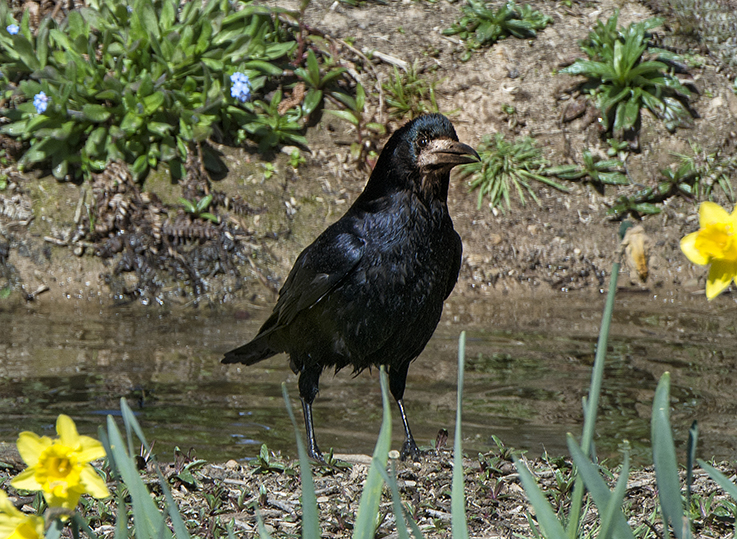 Photo © Keith Littlejohns.
Photo © Keith Littlejohns.
The Rook, Corvus frugilegus is a common bird with around one million pairs breeding each year. It occurs in farmland and open country across the UK, but is rare in mountainous areas and large towns and cities.
The Rook in the above photo was seen at a watery ditch, popular with birds, in fields behind our house.
They are slightly smaller than crows, with a typical wingspan of 90cm. The species’ key identifying feature is the grey-white skin at the base of its long, pointed beak. This distinguishes it from the similar-looking carrion crow, which has an all-black beak.
Worms, beetles and other invertebrates are the rook’s main food, which it catches by probing the ground with its large beak. It will also feed on grain, fruit, acorns and occasionally carrion and birds’ eggs.
Rooks normally build their nests in February or March, but may start as early as January. Rooks are communal breeders, nesting in colonies known as rookeries. Nests are built high in the trees and made of twigs and branches.
Collective nouns for rooks include congregation, storytelling, building, parliament and clamour.
Keith Littlejohns
February 2021 – Collared Dove.
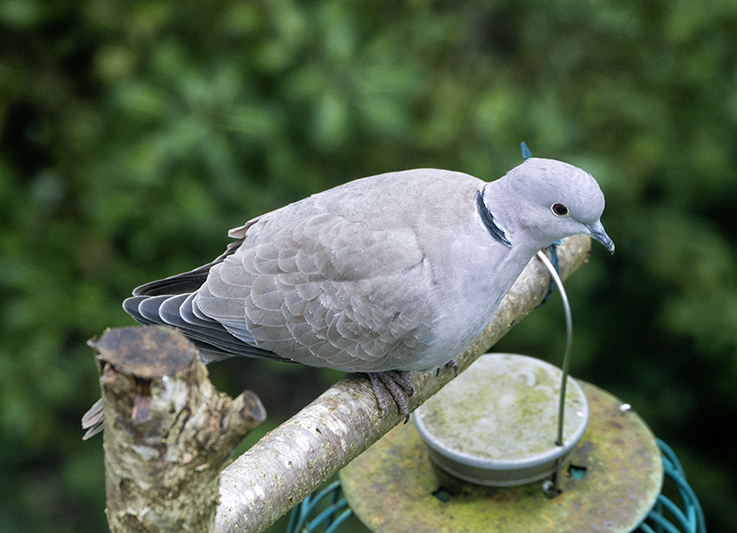 Photo © Keith Littlejohns.
Photo © Keith Littlejohns.
The Collared Dove, Streptopelia decaocto is a member of the pigeon & dove family. They can be seen all year round over the whole UK particularly in woodland, farmland, parks and gardens across the country. Collared doves only started breeding in the UK in the 1950s in Norfolk having arrived from Asia. They are now so widespread that they are one of the top ten most visited birds to British gardens, although numbers have been in decline since 2005.
Length: 31-33cm. Wingspan: 51cm. Weight: 200g. Average lifespan: 3 years, but some individuals have been known to live up to 16 years.
Collared doves are monogamous and can breed continuously in warm regions. They may also start a new nest before the previous young are independent, with the female using breaks from incubation to feed recently fledged offspring. When a pair has eggs in the nest, the female will incubate the eggs during the day before swapping over at dusk for the male to incubate through the night.
Collared dove nests usually just consist of a platform of sticks. They normally nest in trees or shrubs but will also use buildings, favouring ledges, guttering, and the brackets of security lights or satellite dishes.
Collared doves feed on seeds and grain on the ground and are usually seen singularly or in pairs, although small flocks may form where there is enough food.
Classified in the UK as Green under the Birds of Conservation Concern 4: the Red List for Birds (2015).
Keith Littlejohns
February 2021 – Sparrowhawk.
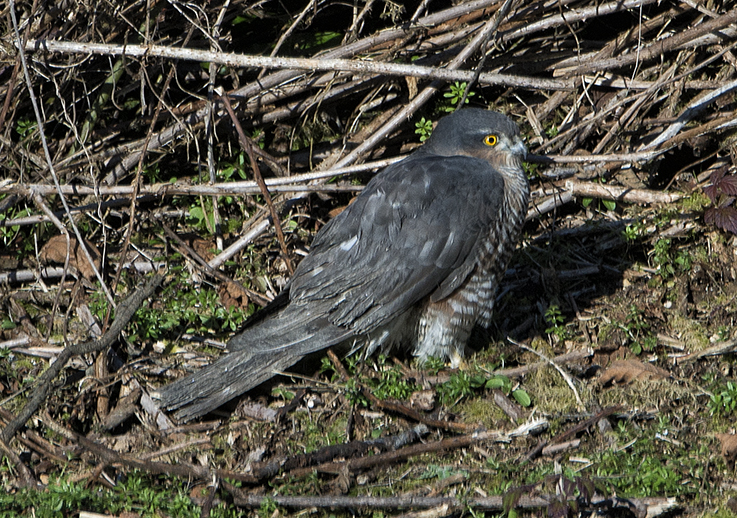 Photo © Keith Littlejohns.
Photo © Keith Littlejohns.
The sparrowhawk, Accipiter nisus is a small bird of prey, the male being somewhere between a blackbird and a collared dove in size, that can be found in all kinds of habitats. Females are much larger, with browner plumage above and grey bars below. Both male and female have reddish cheeks.
This one above, a male, was seen in the wooded area behind our house having just landed with its prey. They often visits gardens looking for prey, mainly small birds like finches, tits and sparrows.
Sparrowhawks nest in woodland areas. Both male and female build the nest in a fork of a tree. It is a platform made of sticks and twigs with little or no additional vegetation.
Sparrowhawks lay 2-7 white eggs that are smooth and glossy and have a bluish tint and dark brown markings. The female incubates the eggs for 32-34 days. When hatched the chicks are fed by the female with prey brought by the male. They fledge at 26-30 days but are fed for a further 25 days. Sparrowhawks reach sexual maturity between 1 and 3 years.
Keith Littlejohns
February 2021 – Grey Squirrel.
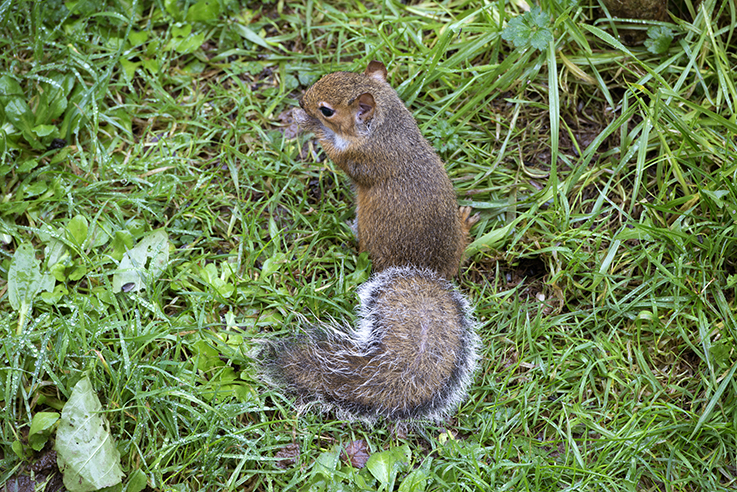 Photo © Keith Littlejohns.
Photo © Keith Littlejohns.
Although having a coat sometimes tinged with orangey red fur, this is actually a grey squirrel, Sciurus carolinensis. The well fed look and short ears are typical of the grey. By comparison red squirrels are smaller, leaner and have longer, tufty topped ears.
Grey squirrels are native to North America and have become an invasive species. They were first released in the UK in 1876 at Henbury Park, Cheshire. It’s not clear why they were introduced and the Victorians had no idea of the risks of introducing non-native species.
Grey squirrels, as would be expected, are a typically a common visitor at our garden bird feeding station. Despite us having so-called squirrel-proof bird feeders they do manage to get a feed by devouring any food spilt by birds onto the grassy ground below the feeders (photo above).
At autumn time they also devour a huge amount of hazel nuts from the many trees in the wooded area over the other side of the leat from the back of our house. We watch them collecting the hazel nuts and burying them in the ground, which they also manage to do in plant pots and borders in our garden as well. Hazel seeds germinate very easily and is why there are so many hazel trees in the woodland close to us – all thanks to wildlife.
Keith Littlejohns
January 2021 – Redwing.
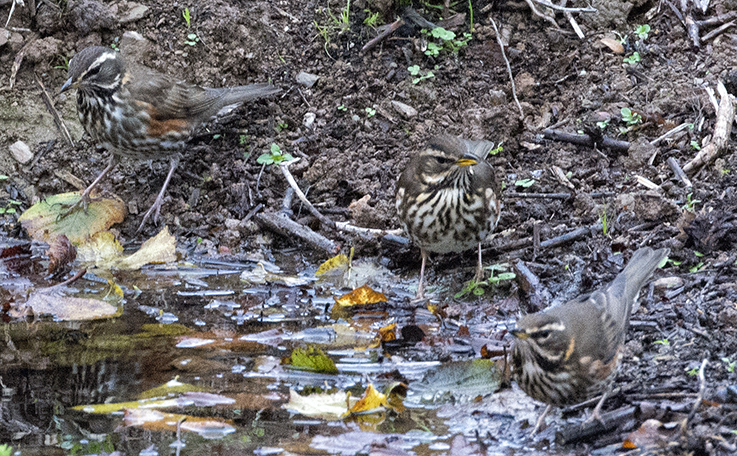 Photo © Keith Littlejohns.
Photo © Keith Littlejohns.
Whilst casually looking at the abundance of wildlife activity in the woodland landscape behind our house this month I noticed a not seen before group of Redwings, Turdus iliacus drinking from a watery ditch. This is my first sighting of these birds in this part of the world, although the south west is one of the UK areas that normally plays temporary host to this particular species of thrush.
The redwing is most commonly encountered as a autumn/winter bird here and is the UK’s smallest true thrush at just 21cm long, with a wingspan of 33-35cm and weighs in at 50-75g. Its creamy coloured strip above the eye and distinctive orange-red flank patches make it easy to identify.
It’s a bit of a social nomad favouring the countryside, feeding in fields and hedgerows and only rarely visit gardens, except in the coldest weather when snow covers the fields. It’s unusual to see pairs nesting in the UK.
They normally feed on berries and worms, which this particular woodland environment is perfect for as there are several berried trees species such as hawthorn and blackthorn as well as ivy for several different berry eating birds to feed on.
Redwing are listed as a Schedule 1 species of The Wildlife and Countryside Act.
Keith Littlejohns


